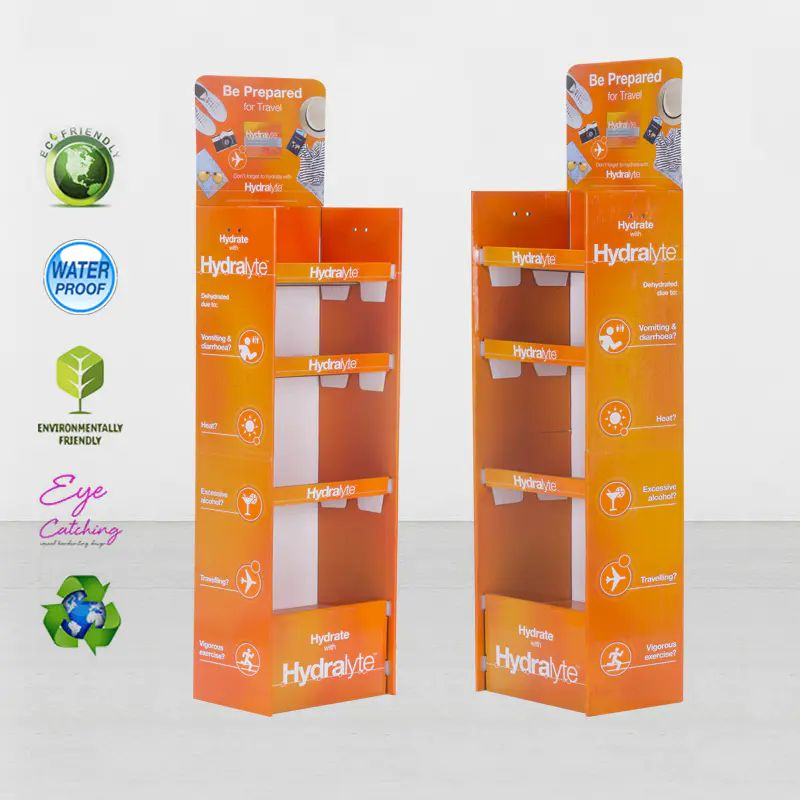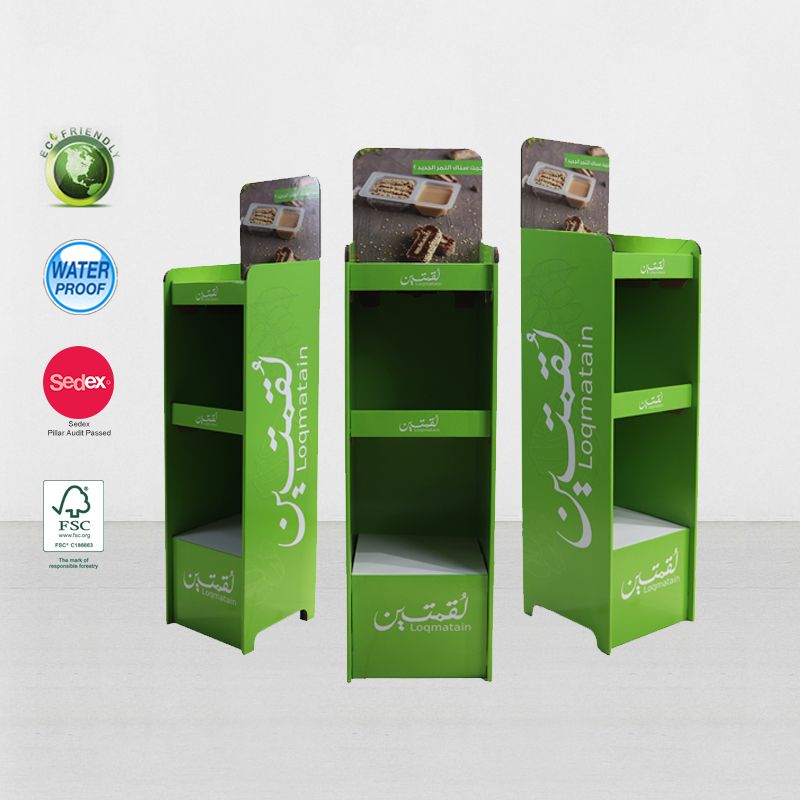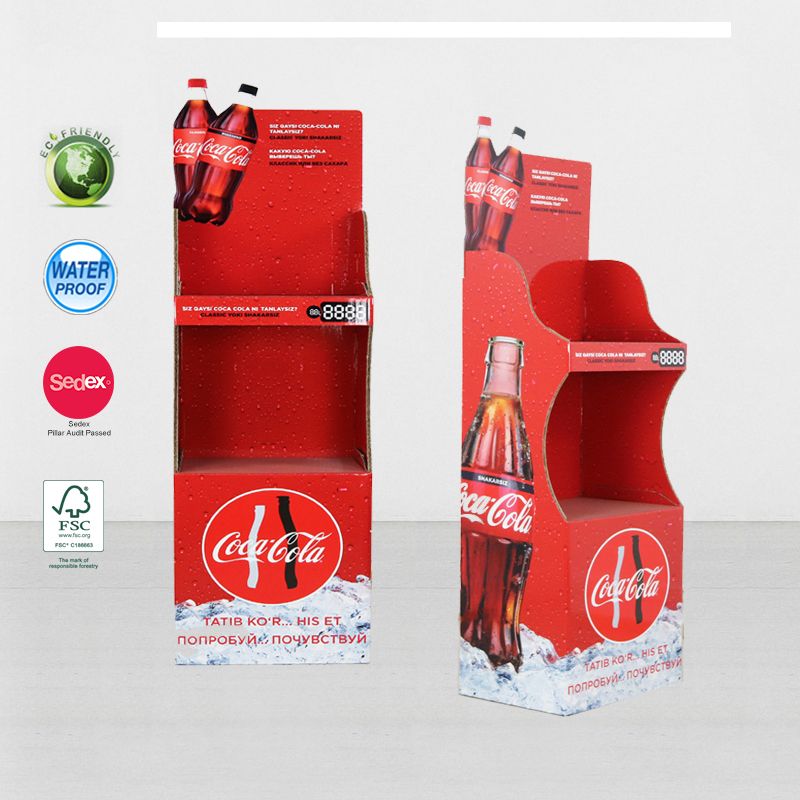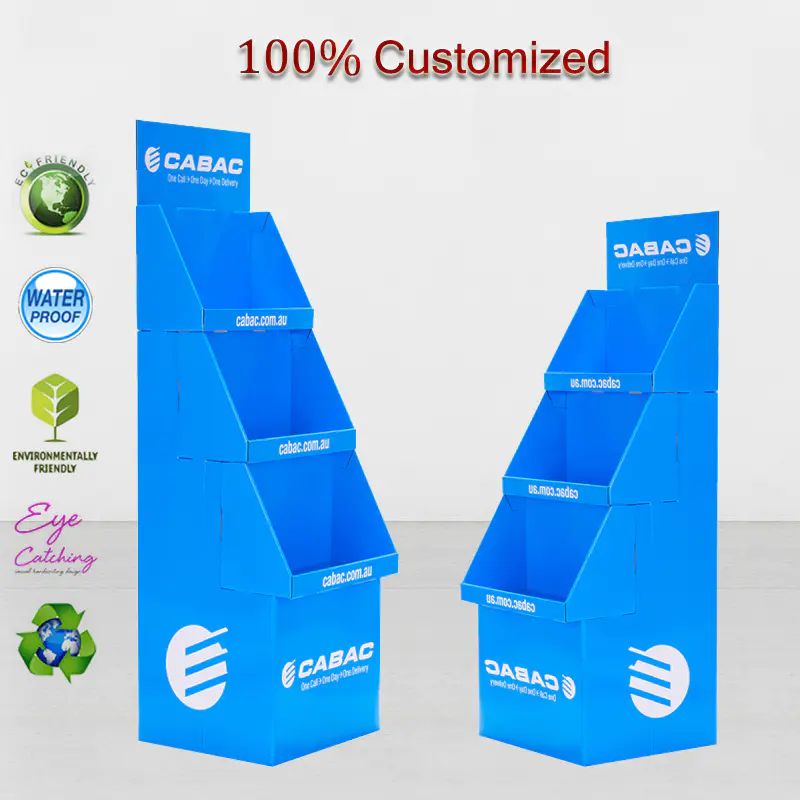In today's competitive retail market, cardboard display stand has become an important tool for merchants to display products due to its advantages such as environmental protection, economy and flexibility. However, different types of cardboard display racks have different effects and applicability in actual applications.
So, which type of cardboard display rack is the best? This article will analyze in detail the types, characteristics, applicable scenarios, advantages and disadvantages of various cardboard display racks to help merchants choose the cardboard display rack that best suits their needs.

What types of cardboard display racks are there?
Five types of cardboard display racks:
1. Standard cardboard display rack,
2. Hook-type cardboard display rack,
3. Rotating cardboard display rack,
4. Stack-type cardboard display rack,
5. Customized cardboard display rack.
1. Standard cardboard display rack:
● Features: Standard cardboard display rack is usually a rectangular structure, divided into multiple layers, which can hold various commodities. It has a simple design, low production cost and easy assembly.
● Applicable scenarios: Suitable for displaying regular goods in supermarkets, convenience stores, exhibitions and other places, such as snacks, beverages, cosmetics, etc.
Advantages and disadvantages of standard cardboard display rack:
● Advantages: economical, wide range of applications, easy to assemble and disassemble.
● Disadvantages: ordinary design, weak visual impact, not suitable for high-end brands and special display needs.
2. Hook-type cardboard display rack:
● Features: The hook-type cardboard display rack is equipped with multiple hooks on the main structure, which can hang various small items, such as ornaments, accessories, stationery, etc. Its display effect is good and the goods are easy to take and put.
● Applicable scenarios: Suitable for displaying small items in retail stores, gift shops, stationery stores and other places.
Advantages and disadvantages of hook-type cardboard display stand:
● Advantages: The displayed goods are neat and beautiful, easy to take and put, suitable for the display of small items.
● Disadvantages: Limited load-bearing capacity, not suitable for heavy goods.
3. Rotating cardboard display rack:
● Features: The rotating cardboard display stand has a rotating function, and customers can view the products on different sides through the rotating display stand. Its unique structure can increase the display area and improve the exposure rate of products.
● Applicable scenarios: Suitable for places such as shopping malls and exhibitions that require all-round display, such as jewelry, cosmetics, mobile phone accessories, etc.
Advantages and disadvantages of rotating cardboard display rack:
● Advantages: Large display area, high product exposure rate, attracting customer attention.
● Disadvantages: Relatively complex structure, high cost, and more troublesome assembly and maintenance.

4. Stacking cardboard display rack:
● Features: The stacking cardboard display stand is designed as a large-capacity display stand that can stack a large number of products. It is usually placed in the promotion area of supermarkets or shopping malls. It has a large capacity and a significant display effect.
● Applicable scenarios: Suitable for promotional activities and holiday sales in supermarkets and shopping malls, such as beverages, washing supplies, snacks, etc.
Advantages and disadvantages of stacking cardboard display rack:
● Advantages: Large capacity, significant display effect, suitable for promotional activities
● Disadvantages: It occupies a large area and is not suitable for small retail stores or places with limited space.
5. Customized cardboard display rack:
● Features: Customized cardboard display rack is designed and produced according to the specific needs of merchants, which can fully reflect the brand image and product characteristics. Its design is flexible and can meet various special display needs.
● Applicable scenarios: It is suitable for brand stores, exhibitions, flagship stores and other places that require unique display effects.
Advantages and disadvantages of customized cardboard display rack:
● Advantages: Flexible design, can fully reflect the brand image and product characteristics, and has a unique display effect.
● Disadvantages: High cost, long design and production cycle.

What are the applicable scenarios of different types of cardboard display stands?
1. Applicable scenarios of standard cardboard display stands:
● Supermarkets and convenience stores: Standard cardboard display racks are widely used in supermarkets and convenience stores to display regular goods such as snacks, beverages, and daily necessities. Its simple design and multi-layer structure can effectively utilize space and improve the display effect of goods.
● Exhibitions and promotions: In exhibitions and promotions, standard cardboard display racks are the preferred display tool for merchants because of their affordability and ease of assembly.
2. Applicable scenarios for hook-type cardboard display racks:
● Retail stores and gift shops: Hook-type cardboard display racks are suitable for retail stores and gift shops to display various small items, such as jewelry, accessories, stationery, etc. Its neat and beautiful display effect can attract customers' attention.
● Exhibitions and temporary displays: In exhibitions and temporary displays, the flexibility and convenience of hook-type cardboard display racks make it an ideal choice for displaying small items.
3. Applicable scenarios for rotating cardboard display racks:
● Shopping malls and large retail stores: Rotating cardboard display racks are suitable for shopping malls and large retail stores to display products that need to be displayed in all directions, such as jewelry, cosmetics, mobile phone accessories, etc. Its unique rotation function increases the display area and exposure rate of the products.
● Exhibitions and promotions: In exhibitions and promotions, the unique structure and high exposure of the rotating cardboard display rack can attract the attention of a large number of customers.
4. Applicable scenarios of the pile-top cardboard display rack:
● Supermarket and shopping mall promotion area: The pile-top cardboard display stand is suitable for the promotion area of supermarkets and shopping malls, and is used to stack a large number of promotional products, such as beverages, washing supplies, snacks, etc. Its large capacity and significant display effect can increase the sales of promotional products.
● Holiday sales: In holiday sales, the pile-top cardboard display rack has become a powerful tool for merchants' promotional activities due to its large capacity and significant display effect.
5. Applicable scenarios of customized cardboard display rack:
● Brand stores and flagship stores: Customized cardboard display racks are suitable for brand stores and flagship stores to display brand image and high-end products. Its unique design and high-end display effect can enhance brand image and product value.
● Exhibitions and large-scale exhibitions: In exhibitions and large-scale exhibitions, customized cardboard display racks can be designed according to the specific needs of merchants to fully demonstrate the uniqueness of brands and products.

What factors should be considered when choosing a cardboard display rack?
When choosing a cardboard display rack, you need to consider: display needs, budget, venue restrictions, and brand image.
1. Display needs:
● Product type: Choose a suitable cardboard display stand according to the type of goods to be displayed. For example, small items are suitable for hook-type display racks, and large-capacity items are suitable for pile-type display racks.
● Display effect: Consider the needs of display effects and choose a cardboard display rack with unique design and significant display effect. For example, a rotating display rack can increase the exposure of goods, and a customized display rack can enhance the brand image.
2. Budget:
● Cost considerations: Choose a suitable cardboard display rack according to the budget. For example, standard display racks are economical and suitable for merchants with limited budgets; customized display racks are more expensive and suitable for brands with sufficient budgets and large-scale exhibitions.
● Cost-effectiveness: Consider cost-effectiveness and choose a cardboard display rack that can meet display needs and control costs. For example, hook-type display racks and standard display racks perform well in terms of cost-effectiveness.
3. Venue restrictions:
● Space size: Choose a suitable cardboard display rack according to the size of the display venue. For example, small retail stores are suitable for display racks with a small footprint, while large shopping malls and exhibitions are suitable for large display racks with significant display effects.
● Placement: Consider the placement of the display rack and choose a display rack suitable for that location. For example, high-exposure display racks are suitable for the entrance and near the cash register, and stack-type display racks are suitable for the promotion area.
4. Brand image:
● Brand consistency: Choose a cardboard display rack that is consistent with the brand image. For example, high-end brands can choose beautifully designed customized display racks, while ordinary brands can choose simple and practical standard display racks.
● Brand communication: Convey brand information through display racks and choose display racks that can reflect brand values and characteristics. For example, brand elements and product features can be integrated into the display rack to enhance brand awareness.
Summary
Choosing a suitable cardboard display rack is crucial to improving product display effects and attracting customer attention. Different types of cardboard display stands have different characteristics, applicable scenarios, advantages and disadvantages. Merchants should consider their own display needs, budget, site restrictions, brand image and other factors comprehensively and choose the most suitable type of display stand.

